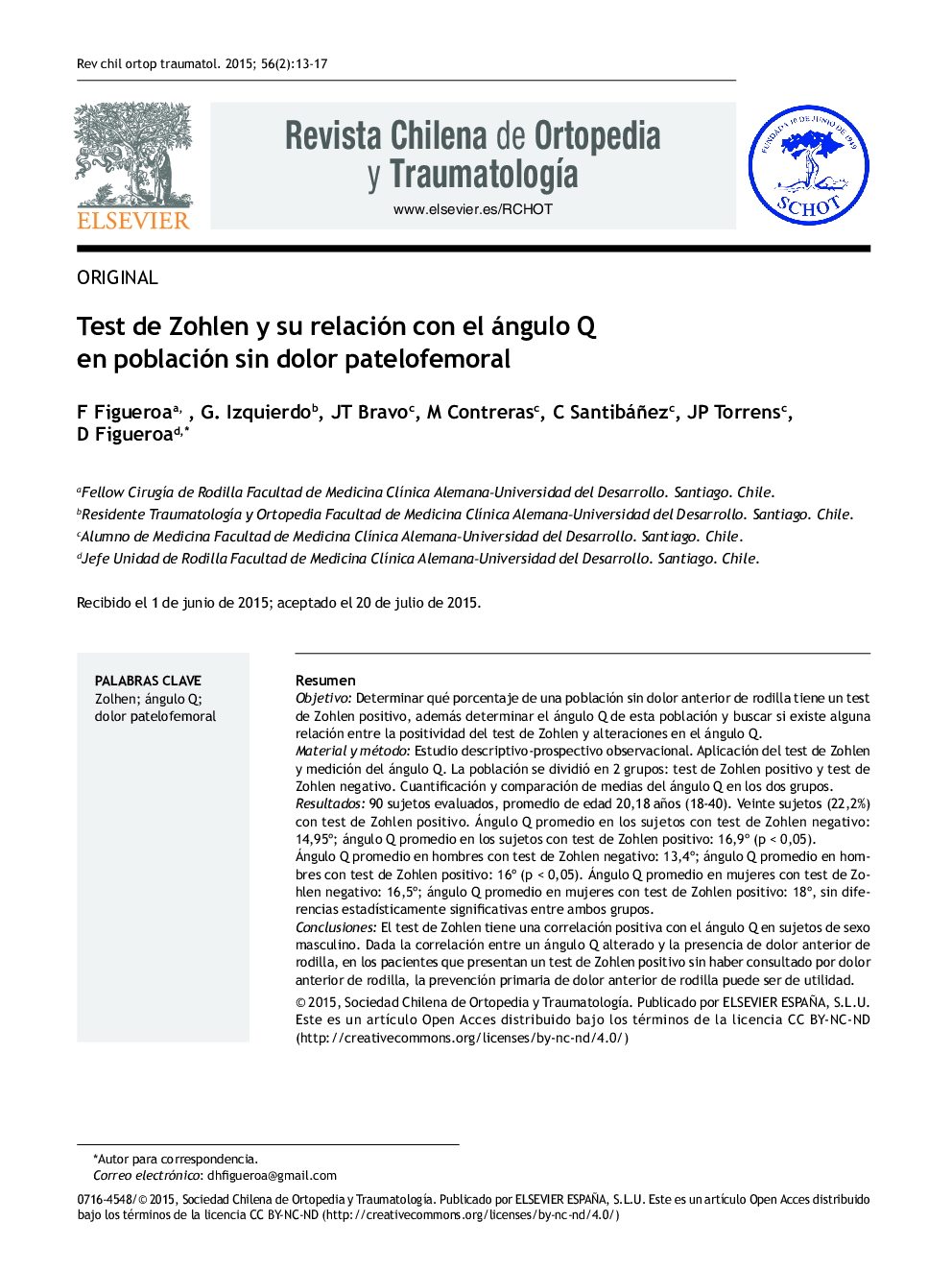| کد مقاله | کد نشریه | سال انتشار | مقاله انگلیسی | نسخه تمام متن |
|---|---|---|---|---|
| 4086013 | 1267918 | 2015 | 5 صفحه PDF | دانلود رایگان |

ResumenObjetivoDeterminar qué porcentaje de una población sin dolor anterior de rodilla tiene un test de Zohlen positivo, además determinar el ángulo Q de esta población y buscar si existe alguna relación entre la positividad del test de Zohlen y alteraciones en el ángulo Q.Material y métodoEstudio descriptivo-prospectivo observacional. Aplicación del test de Zohlen y medición del ángulo Q. La población se dividió en 2 grupos: test de Zohlen positivo y test de Zohlen negativo. Cuantificación y comparación de medias del ángulo Q en los dos grupos.Resultados90 sujetos evaluados, promedio de edad 20,18 años (18-40). Veinte sujetos (22,2%) con test de Zohlen positivo. Ángulo Q promedio en los sujetos con test de Zohlen negativo: 14,95°; ángulo Q promedio en los sujetos con test de Zohlen positivo: 16,9° (p < 0,05).Ángulo Q promedio en hombres con test de Zohlen negativo13,4°; ángulo Q promedio en hombres con test de Zohlen positivo: 16° (p < 0,05). Ángulo Q promedio en mujeres con test de Zohlen negativo: 16,5°; ángulo Q promedio en mujeres con test de Zohlen positivo: 18°, sin diferencias estadísticamente significativas entre ambos grupos.ConclusionesEl test de Zohlen tiene una correlación positiva con el ángulo Q en sujetos de sexo masculino. Dada la correlación entre un ángulo Q alterado y la presencia de dolor anterior de rodilla, en los pacientes que presentan un test de Zohlen positivo sin haber consultado por dolor anterior de rodilla, la prevención primaria de dolor anterior de rodilla puede ser de utilidad.
ObjectiveTo determine the percentage of a population without anterior knee pain with a positive Zohlen test, and also to determine the Q angle of this population and to determine if there is any relationship between the Zohlen test and Q angle anomalies.MethodsA prospective observational study was conducted in which Zohleńs test was applied and the Q angle was measured. The population was divided into 2 groups: Zohleńs positive and Zohleńs negative. Q angle was compared in the 2 groups.ResultsThe study included 90 subjects, with a mean age 20.18 years (18-40), of whom 20 subjects (22.2%) had positive Zohleńs test. The mean Q angle in subjects with negative Zohleńs test was 14.95°, and the mean Q angle in subjects with positive Zohleńs test was 16,9° (p<.05). The mean Q angle in men with negative Zohleńs test was 13.4°, and the mean Q angle in men with positive Zohleńs test was 16° (p < .05). The mean Q angle in women with negative Zohleńs test was 16.5°, with a mean Q angle of 18° in women with positive Zohleńs test, with no statistically significant differences found between groups.ConclusionsZohleńs test has a positive correlation with the Q angle in male subjects. Given the correlation between the Q angle and the presence of anterior knee pain in patients who have a positive test without symptoms, primary prevention of anterior knee pain can be achieved.
Journal: Revista Chilena de Ortopedia y Traumatología - Volume 56, Issue 2, May–August 2015, Pages 13–17